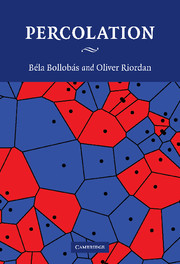Book contents
- Frontmatter
- Contents
- Preface
- 1 Basic concepts and results
- 2 Probabilistic tools
- 3 Bond percolation on ℤ2 – the Harris–Kesten Theorem
- 4 Exponential decay and critical probabilities – theorems of Menshikov and Aizenman & Barsky
- 5 Uniqueness of the infinite open cluster and critical probabilities
- 6 Estimating critical probabilities
- 7 Conformal invariance – Smirnov's Theorem
- 8 Continuum percolation
- Bibliography
- Index
- List of notation
1 - Basic concepts and results
Published online by Cambridge University Press: 05 June 2012
- Frontmatter
- Contents
- Preface
- 1 Basic concepts and results
- 2 Probabilistic tools
- 3 Bond percolation on ℤ2 – the Harris–Kesten Theorem
- 4 Exponential decay and critical probabilities – theorems of Menshikov and Aizenman & Barsky
- 5 Uniqueness of the infinite open cluster and critical probabilities
- 6 Estimating critical probabilities
- 7 Conformal invariance – Smirnov's Theorem
- 8 Continuum percolation
- Bibliography
- Index
- List of notation
Summary
Percolation theory was founded by Broadbent and Hammersley [1957], in order to model the flow of fluid in a porous medium with randomly blocked channels. Interpreted narrowly, it is the study of the component structure of random subgraphs of graphs. Usually, the underlying graph is a lattice or a lattice-like graph, which may or may not be oriented, and to obtain our random subgraph we select vertices or edges independently with the same probability p. In the quintessential examples, the underlying graph is ℤd.
The aim of this chapter is to introduce the basic concepts of percolation theory, and some easy fundamental results concerning them.
We shall use the definitions and notation of graph theory in a standard way, as in Bollobás [1998], for example. In particular, if ∧ is a graph, then V(∧) and E(∧) denote the sets of vertices and edges of ∧, respectively. We write x ∈ ∧ for x ∈ V(∧). We also use standard notation for the limiting behaviour of functions: for f = f(n) and g = g(n), we write f = o(g) if f/g → 0 as n → ∞, f = O(g) if f/g is bounded, f = Ω(g) for g = O(f), and f = Θ(g) if f = O(g) and g = O(f).
The standard terminology of percolation theory differs from that of graph theory: vertices and edges are called sites and bonds, and components are called clusters.
- Type
- Chapter
- Information
- Percolation , pp. 1 - 35Publisher: Cambridge University PressPrint publication year: 2006
- 1
- Cited by



